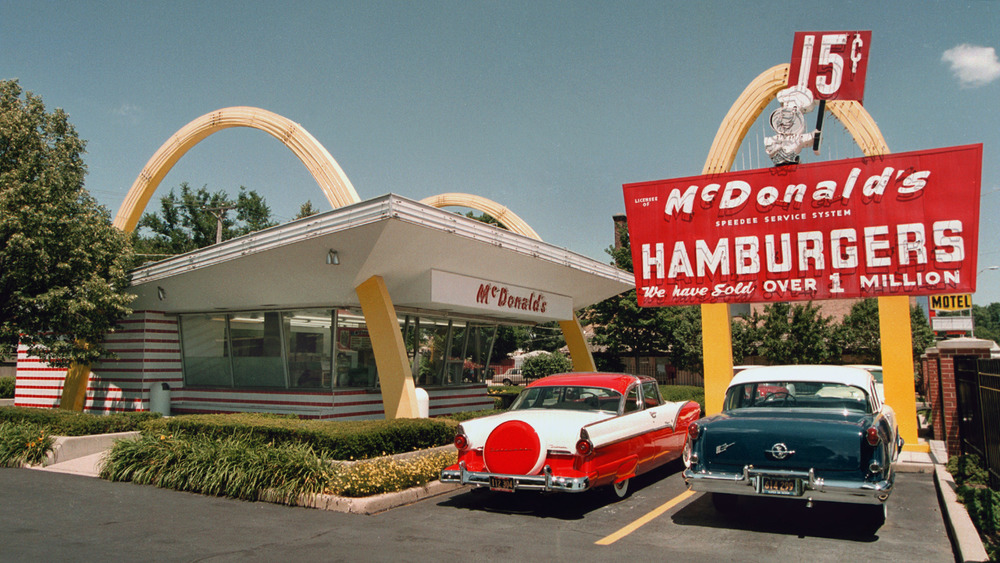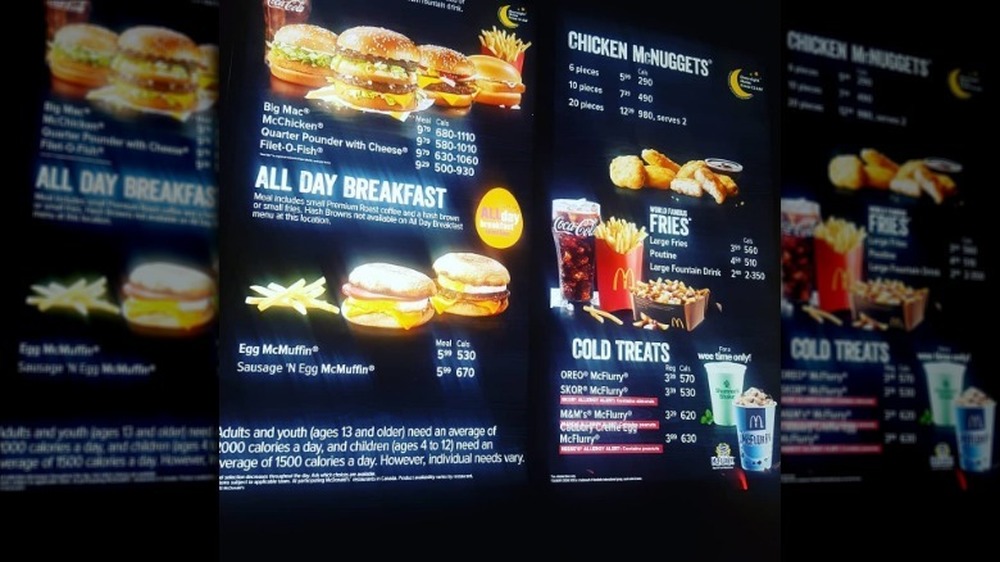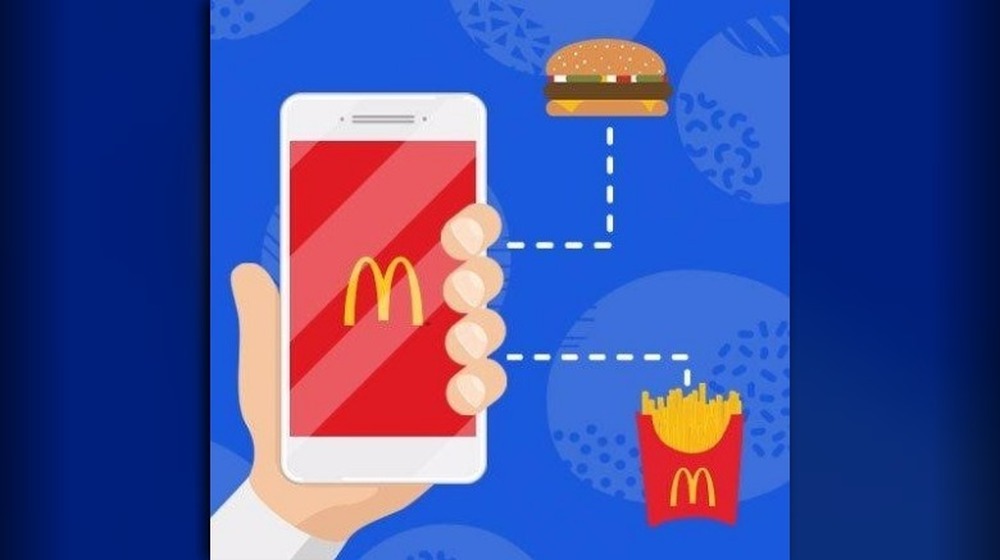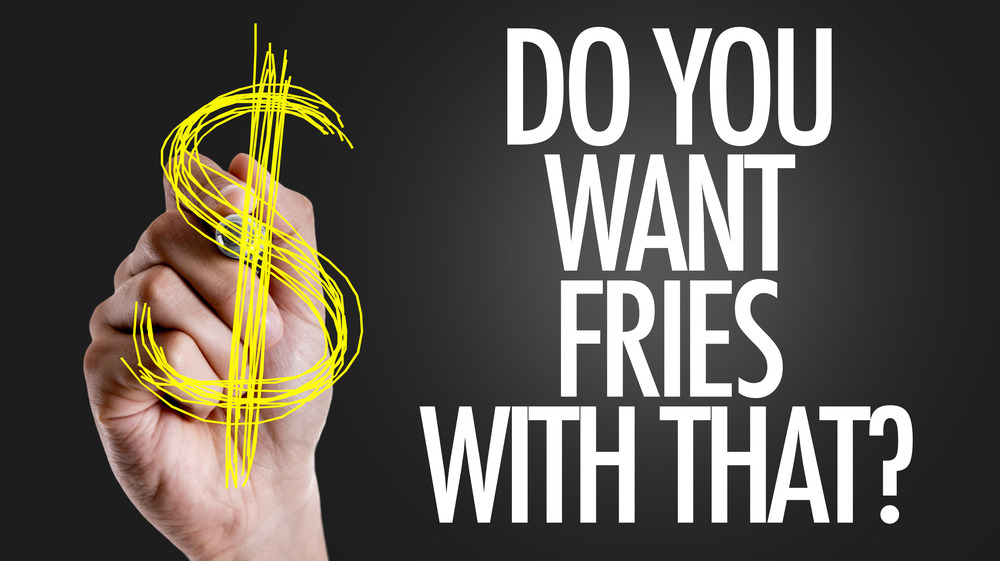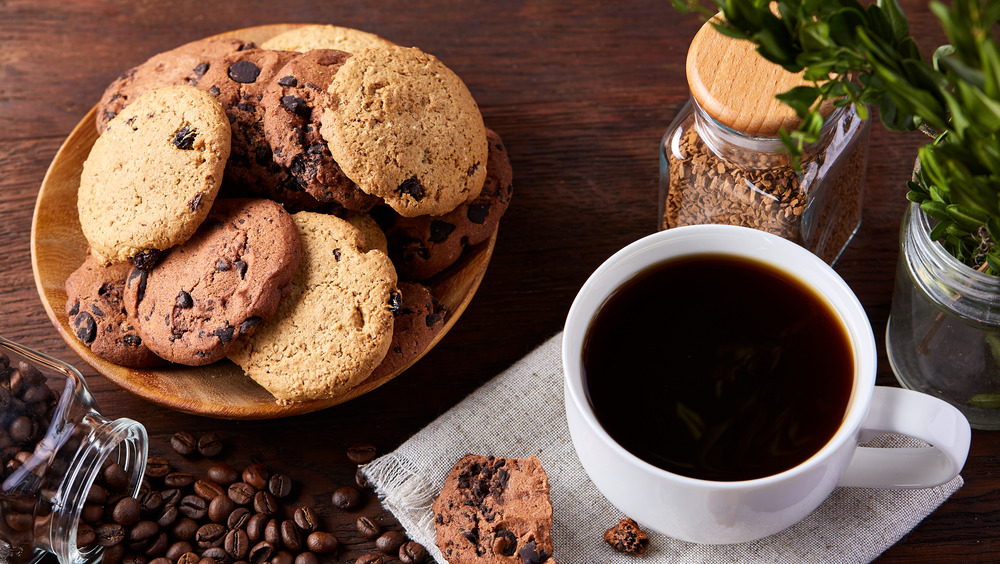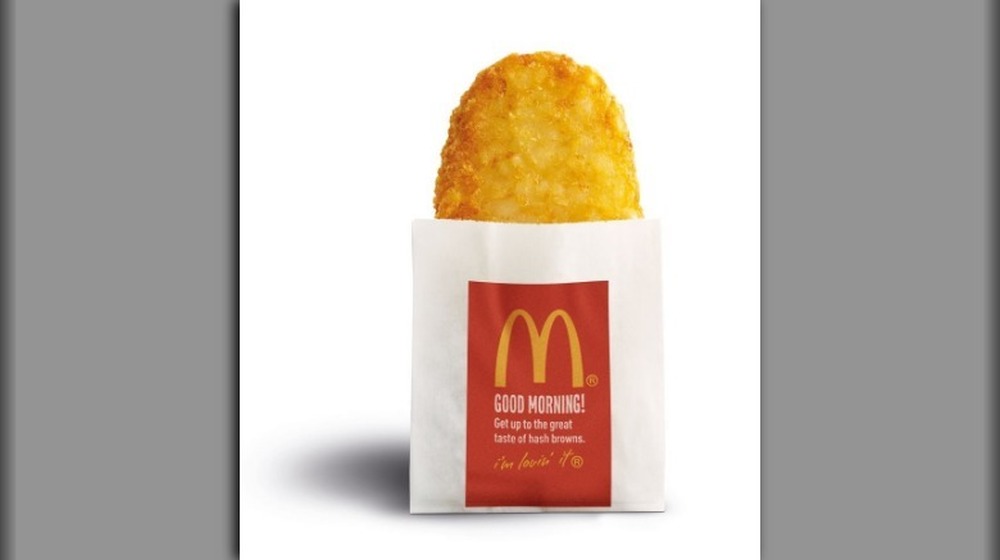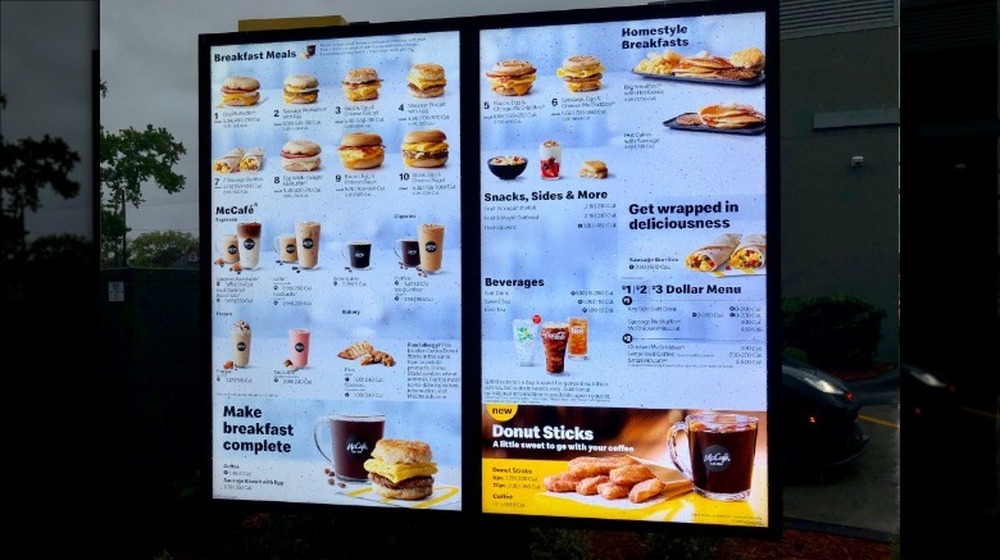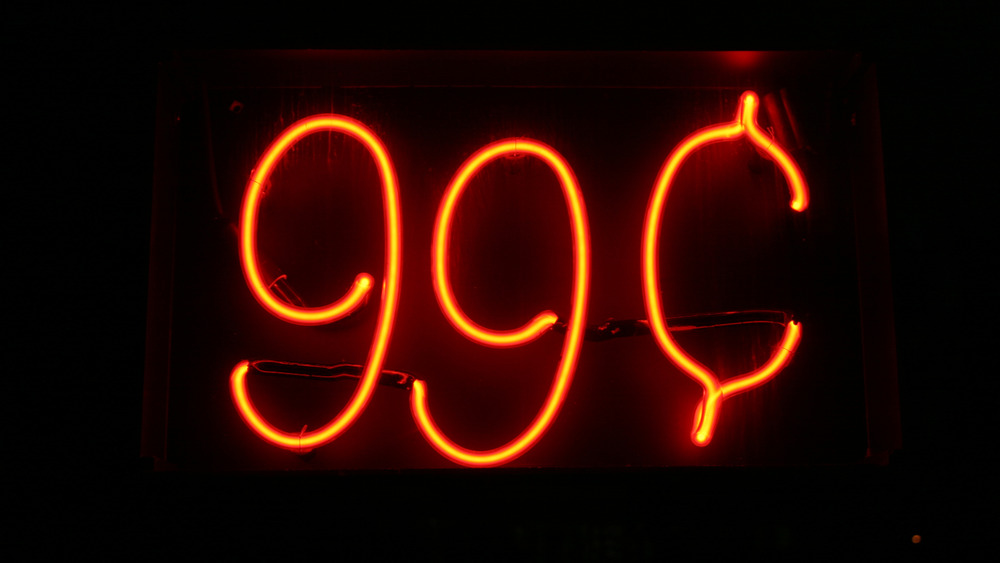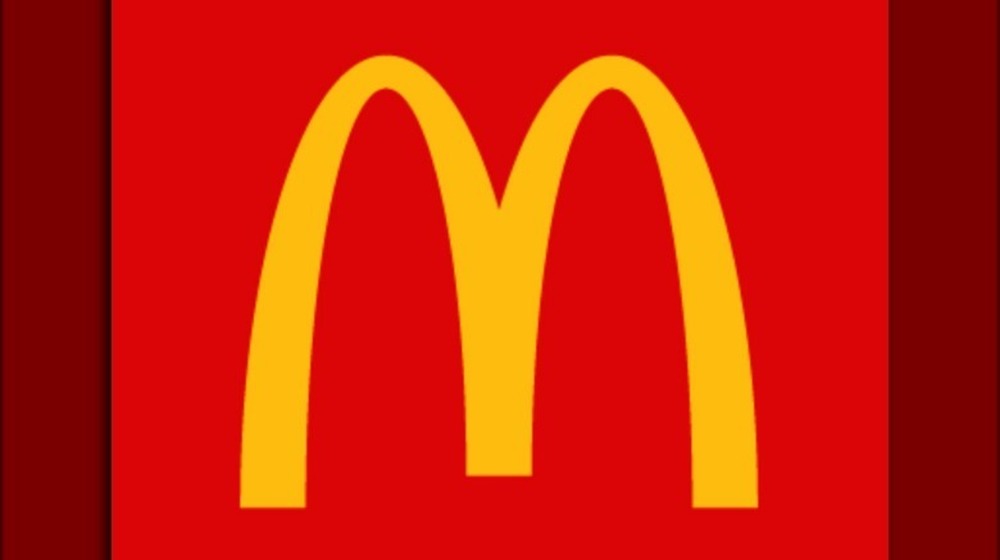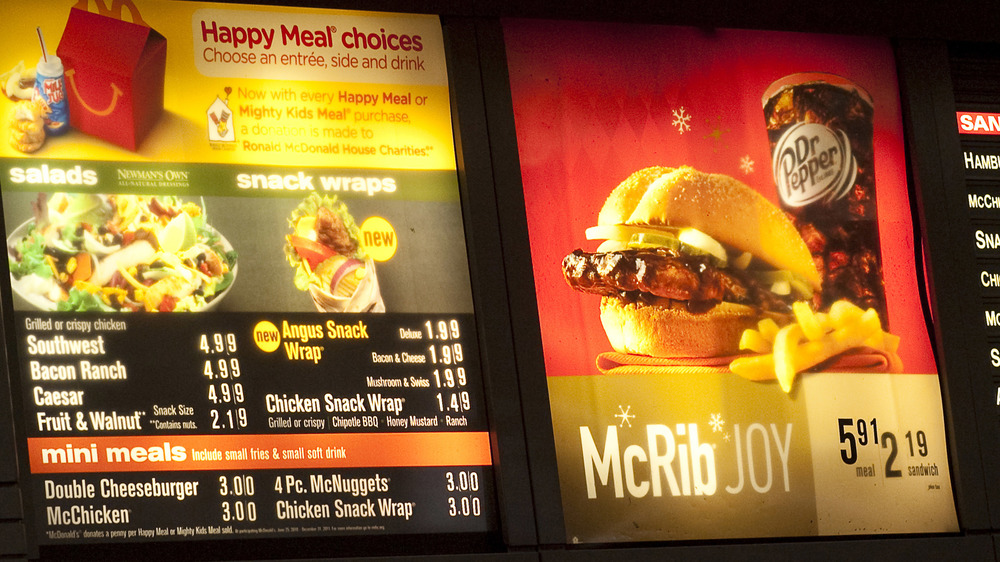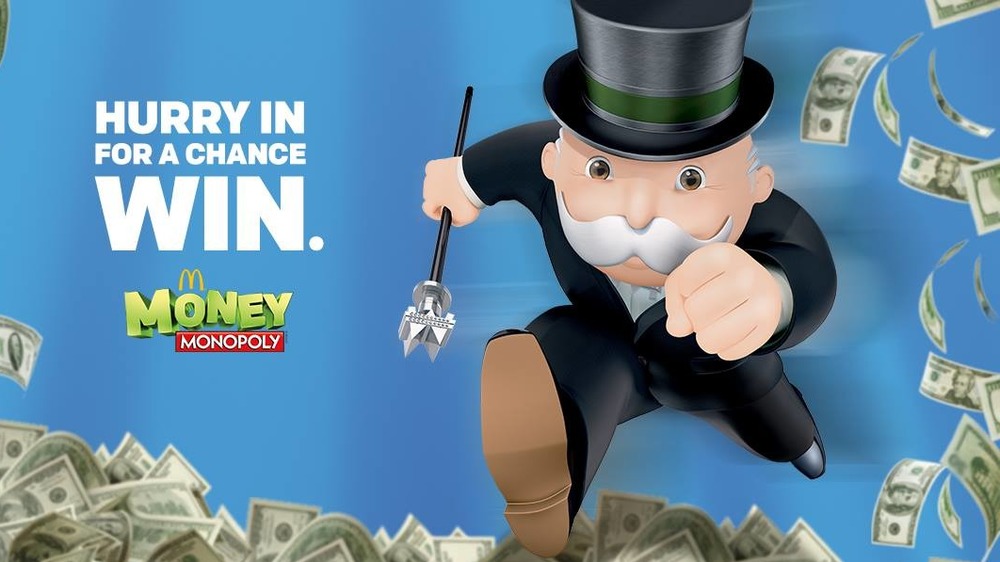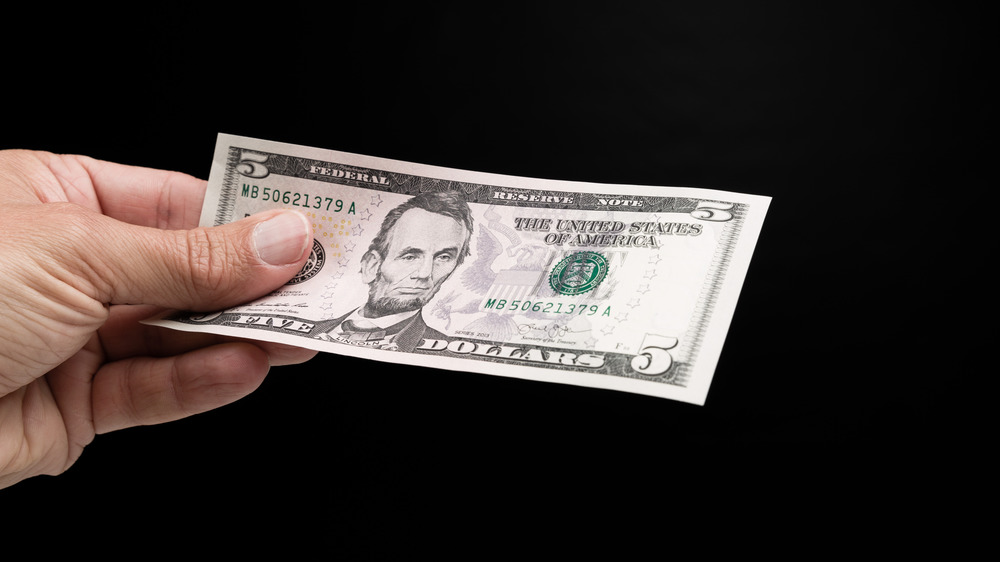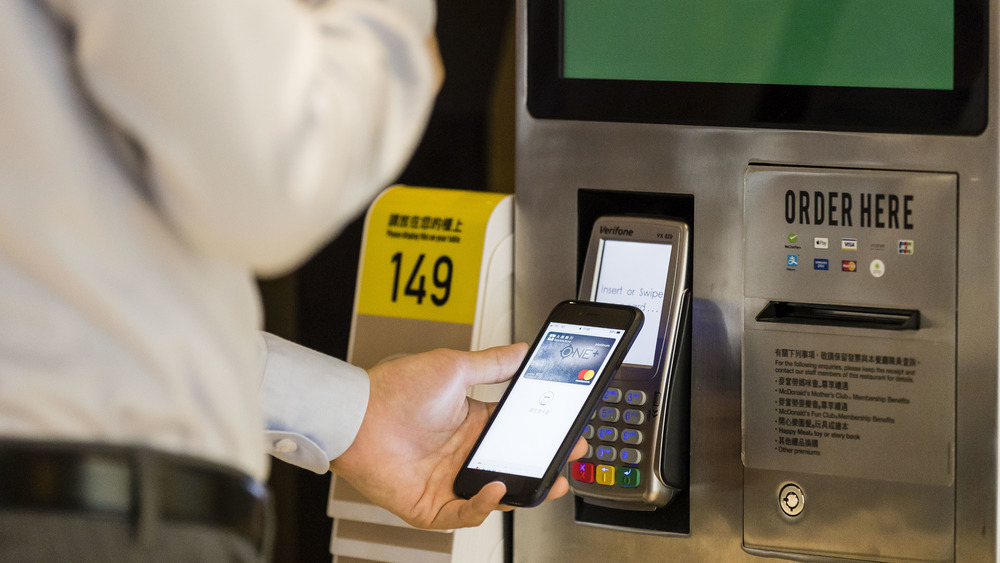Sneaky Ways McDonald's Gets You To Spend More Money
It might be hard to imagine, but there was a time before a bevy of giant, golden Ms glowed on our late-night highways. There was a time before the fictional Hamburglar wanted to steal our burgers. There was a time before a single Stroopwafel McFlurry was on a single menu. There was even a time before McDonald's existed and they thusly couldn't trick anyone into spending more of their cash than they'd originally intended.
However, we don't live in the 1950s, when McDonald's was first launched, so we are stuck with the famous golden arches. We are likewise stuck with their fries, their Big Macs, and their sneaky sales tactics that try to push us to make bigger purchases. Because of this, and also because of the fact McDonald's isn't disappearing into the ether, we may as well all learn about this burger joint's rather devious marketing strategies. That way, the next time we're driving down a late-night highway and start craving some McDonald's munchies, we might not waste so much of our hard-earned cash.
So, without much more fanfare, let's launch into the plethora of different ways McDonald's tries to get us to spend even more money. May this info help you out on your next fast food adventure.
Some McDonald's menus don't feature dollar signs
The human noggin is a pretty spectacular combination of bones, flesh, and organs. That being said, it can also be exploited rather easily for profit. Take, for instance, the fact that, according to Mental Floss, some restaurants don't feature dollar signs on their menus in order to make their potential customers more likely to buy their food.
But why would a person be more likely to purchase a meal if it didn't have a dollar sign at the front of its price? Restaurant consultant Aaron Allen explained the rationale behind this trick to Mental Floss. He said that "We get rid of dollar signs because that's a pain point." Simply put, those dollar signs inconveniently remind you that you're spending actual money, making you think twice about your purchase.
If you ever find yourself standing in a queue at McDonald's, it might be worth checking out whether or not the franchise's menu features dollar signs. Because, after all, like Instagram user Chad Vice recorded, McDonald's has tried this play before. In 2020, Vice took a photo of Canada's new digital menu boards, where most of the items were free of dollar signs.
The McDonald's rewards program can actually cost you
Like a truckload of other companies, McDonald's has a loyalty rewards program that gives out points for each in-store purchase made by a customer. These points can then be traded in for free drinks and food on the customer's next visit. They can also be potentially used to receive other types of items that would typically cost you money.
Now, Mickey D's app might seem all hunky-dory to you, but it's worth reevaluating their program after taking a dive into a 2016 marketing report by Bond Brand Loyalty. In this document, the organization explained that they'd surveyed around 19,000 individuals and discovered that 66% of them alter what they buy if they're a part of a franchise's loyalty program. Respondents claimed that they will often change what they purchase in order to maximize the number of points they receive.
This report indicates that if you're a part of a place's loyalty rewards program, there's a chance that you'll spend more money just trying to increase your total rewards points. So, if you're using the McDonald's app with its rewards program, maybe it's worth thinking about whether or not you're actually sinking extra cash into it. And if you do, perhaps it's time to wave goodbye to this not-so-convenient service.
Your McDonald's cashier could try to upsell you
When you walk into a McDonald's restaurant, it's not just the menus that you should be wary of. Dessy Joseph, a former McDonald's employee, explained how the restaurant's cashiers could potentially upsell their customers. But before we unpack this, what exactly is upselling? As stated in the Cambridge Dictionary, upselling is the act of trying to "persuade a customer who is already buying something to buy more, or to buy something more expensive." Turns out, this is something that Mickey D's might try to do to you.
Joseph clearly outlined how McDonald's upsells its customers. She explained that "After you tell me everything you order, and I repeat it back to you, I then will ask you, 'Would you like an Apple Pie for 89 cents to complete your order today?' I gave you the price, it sounds very cheap. Most people just say, 'Yeah, sure why not?'" Joseph then ends the TikTok by exclaiming that you should refuse this offer because the restaurant is simply just collecting your cash.
McDonald's menu sneakily suggest food pairings
In 2015, viewers might have caught McDonald's newfangled digital menus on YouTube, where they saw how these boards advertise what's available for purchase at McDonald's franchises. During this video, a narrator explains that the updated McDonald's menus will feature moving food pictures. They can also change what's being promoted, depending on the time of day or night.
The narrator also admits that these digital menus suggest food pairings that could change what a customer orders. As they assert, "Most people would love the delicious pairing of McCafe drinks with deserts and don't even know it. So, we help them connect the dots." As the narrator says this, a picture of a McCafe beverage next to some cookies is displayed on one of the corporation's menu boards. You may even be distracted by other subtle menu tricks, like the small animations McDonald's adds to its digital boards.
If you were to go into a McDonald's to just purchase a hot drink, like a simple coffee, you might see this very board. If it pushes you to add the chain's chocolatey baked goods to your order, then this fast food joint would have made you spend that much more money. So, if you're wading through one of their menus, perhaps you should be on your guard against their food pairing suggestions. There's a chance that you don't want to be upsold by one of these ads.
McDonald's surprised folks with sneaky price hikes
If you were to head out in the hopes of snagging a snack, you'd probably be disappointed if the fast food restaurant that sold them had increased the item's price overnight. McDonald's Australia did exactly this with their hash browns in 2017, as reported by PerthNow. According to a McDonald's employee interviewed by the news outlet, one day the McDonald's hash browns were $1.95. The next, they were $2.20.
Soon after the restaurant implemented this price hike, not all of their customers were impressed with this decision. One patron even went so far as to call the price hike "outrageous and ridiculous." A spokesperson for McDonald's commented on this situation by saying, "We're proud to offer our customers great value, but like all business from time to time we review our prices which may result in slight changes."
It's also worth noting that McDonald's Australia has changed the cost of their menu items on more than this one occasion. In 2019, New Idea Food reported that the chain had raised the price of their famous Big Mac by 50 cents, raising the price to a total of $1.50. This news gained some traction, where few people were happy to see the new expense at Macca's, as it's popularly known in Australia. "Has anyone else noticed that the $1 hamburgers at Macca's have gone up to $1.50?" asked one customer. "They snuck that one in."
McDonald's digital drive-thru menus recommend sneaky add-ons
According to The New York Times, not every McDonald's drive-thru is the same as it used to be years ago. Now, when you visit their drive-thru, chances are good that you'll encounter digital menu boards outside the restaurant. These boards are more sophisticated and customizable, to be certain. They also use artificial intelligence to predict what a customer like you might be tricked into buying after you've already put in your order. Of course, this might result in you spending more money than you'd initially bargained for, all thanks to a sophisticated computer program.
In the event that you're at an upgraded McDonald's drive-thru, try to resist this new era of upselling. After all, if you didn't order an item in the first place, then chances are good that you don't really want or need it. There's probably not much of a point in purchasing an extra dish just because Mickey D's or its fancy new drive-thru menu boards suggest that you do so.
The way McDonald's prices items get sneaky
If you've ever noticed the phenomenon of McDonald's menu items coming in at, say $3.99 instead of a simpler $4.00, you may have had some questions. There's a simple but potentially disappointing reason for the weird pricing, according to Live Science. Lee E. Hibbett, a marketing professional at Freed-Hardeman University, told the publication that these items just sell better. He explained that, because we read from right to left in English, we might unconsciously think that the first number in a price is the most important. So, if you notice that a product costs $4.99 at one place and $5.00 at another, you could be sneakily led to believe that the scarcely cheaper version is the superior purchase.
According to Real Menu Prices, quite a few McDonald's menu items use this little trick. For instance, their Big Mac, their 6-pack of chicken McNuggets, their sausage with egg on a biscuit meal, their steak, egg, and cheese bagel, and two of their egg McMuffin meals each cost $3.99. It takes a little extra mental effort to remind yourself that all of these products are only one cent away from $4.00.
McDonald's signature colors are a sneaky way to make you spend
Red and yellow are pretty common colors in the world of fast food. As the journal Management Decision reported, it's a common belief in the marketing community that these two colors can affect a person's mood. Some argue that the color red can impact a person's metabolism in such a way that will make the individual even hungrier than before they spotted the color. Moreover, various marketers reckon that yellow may also intensify a potential customer's appetite. All the better for fast food restaurateurs trying to make some extra cash.
While these beliefs aren't fully backed up by scientific experiments, they have certainly influenced our culture and fast food joints across the world. The color red is favored by some quick-service restaurants like McDonald's because it's believed that it'll make a location's customers want more food, while yellow will supposedly help to quickly sell products. Whether or not consumers' tastes are really influenced by these hues, the notion that they can do so is now fully entrenched in fast food culture.
Careful observers will have already noticed that there are only two colors used in the McDonald's logo. The restaurant chain uses a bright yellow M, popularly known as the "golden arches", on a similarly eye-catching red background. Do with this information what you will.
McDonald's food photos can make you hungrier
Have you ever noticed a picture of some food and then become hungry almost immediately? According to Popular Science, that's a pretty common phenomenon. Princeton University neuroscientist Michael Graziano told the publication that humans "did not evolve in a world of pictures." So, when we admire a scrumptious photo of a meal, our brain chemistry makes us both emotionally stimulated and hungry, as if we could reach out and bite into it. Some part of our brain thinks that we're looking at the real thing, not a mere representation.
Now, at this point, it could be worth asking yourself, "Am I the sort of person who buys more food when I'm hungry?" If you think you are, then perhaps you're susceptible to this trick. It could help to review what McDonald's is selling on a pictureless site like Real Menu Prices. The fancy new digital menus at McDonald's are packed full of high-quality pictures that might just increase your appetite.
McDonald's Monopoly game makes you come back for more
Occasionally, McDonald's will host McDonald's Monopoly, a game that partly consists of purchasing Mickey D products that sport little tokens similar to those found in the popular board game. Though it's once turned into a scandal for the chain, the Monopoly promotion is still a popular event today. These tokens may provide you with a free meal or a bit of money. Some tokens are part of unique sets, such as Pennsylvania Avenue or B&O Railroad. If you collect all of the tokens in a specific set, then you're eligible to win a big prize.
This game has influenced some of its players' purchasing habits. Indeed, there have even been instances where the company has admitted that this is its ultimate goal. In 2003, Chris Hess, The Marketing Store's vice president of strategic business partnerships, told Promo Magazine that McDonald's added an online component to this experience which enticed its player-base. "We've found that when people play the online Monopoly game, there's a level of customer engagement that keeps them coming back," he said. "They're quicker to get back into the store and revisit."
The Toronto Star reported that McDonald's Monopoly was partly responsible for increasing their overall sales by 5.6 percent throughout the month of October. So, these games might seem worth it for the fast food giant. Yet, they could make you return to a McDonald's faster in the hopes of winning big, all while spending your actual money.
McDonald's deals are sneaky ways to make you spend
In 2018, the BBC reported that McDonald's had launched its "$1 $2 $3 Dollar Menu" in the United States. This ultra-cheap menu had a very self-explanatory name, as every item on its list cost three dollars or less. One of the biggest selling points for this menu, arguably, was the fact that consumers could snag an entire burger for a mere dollar.
How can these low-cost McDonald's products turn a profit for the chain? University of Michigan-Dearborn economics professor Patricia Smith explained the McDonald's plan to the BBC, saying that "McDonald's will make money selling burgers for a buck if it can make the burger for less than $1 and sell lots and lots of burgers." It doesn't end there, either. "Part of the strategy is to attract consumers in to the store and then entice them to buy more than just the burger – fries, drinks, desserts," said Smith.
So, how did this plan turn out for them? In 2019, Business Insider reported that McDonald's had scrapped their "$1 $2 $3 Dollar Menu" because it just didn't live up to the company's ambitions. That being said, this joint then promoted their "2 for $5.00 deals," a new initiative with a similar structure to the previous dollar menu venture.
McDonald's diners spend more at surprisingly sneaky kiosks
If you're the sort of person that doesn't want to be upsold by a McDonald's cashier or drive-thru, you might head to one of their self-serve kiosks. These new additions to the McDonald's sales arsenal might offer some peace and quiet, but don't think you'll escape the upselling even here. As Restaurant Business reported, McDonald's had been steadily adding these kiosks to stores that have undergone refurbishment. Early data indicates that people regularly spend more at these machines than if they were talking to a real-life McDonald's employee at the now relatively old-fashioned counter
If you want your next McDonald's visit to be a cheap one, it turns out that ordering your meal at a kiosk might not be your best bet. Then again, an in-person order could mean that Mickey D's worker may try to upsell additional menu items to you, while their drive-thru menus subconsciously suggest that you buy some extra items. If you really want to save some cash, decide on your order ahead of time and resist the sneaky ways that McDonald's gets you to spend more money.
